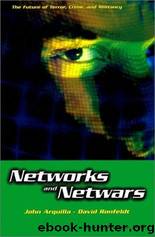Networks and Netwars: The Future of Terror, Crime, and Militancy by John Arquilla

Author:John Arquilla
Language: eng
Format: mobi, azw3, epub
ISBN: 9780833030306
Publisher: RAND Corporation
Published: 2001-10-26T04:00:00+00:00
186 Networks and Netwars: The Future of Terror, Crime, and Militancy There was impressive solidarity and harmony when a swarm took shape around a hot issue, such as demanding a halt to military operations or pressing for the release of an imprisoned Zapatista. At the same time, there was never complete solidarity and harmony among all members of the Zapatista networks at all times. According to our interviews, coordination was not always smooth. Problems and differences would get worked out most readily among activists present in the conflict zone, while the tone of debate might be quite different and more contentious in Mexico City. Indeed, some significant tensions existed, and surfaced, that had limiting effects.
For example, the EZLNâs initial rhetoric in January 1994 was quite socialist in style and content, and it barely acknowledged the importance of indigenista issues like cultural rights and autonomy. In February, following Marcosâs lead, a rebalancing occurred: The socialist rhetoric diminished, and demands for attention to indigenous rights came to the fore (see Van Cott, 1996, pp. 74â77; Nash, 1995). This reas-sured many indigenous-rights NGOs that were already supporting the EZLN. Yet some wanted to see even more Indian and less Marxist language used, and wanted the EZLN to join in building a pan-Indian movementâbut the EZLN remained determined to keep its goals in a nationalist framework. From another perspective, some leftist activists were not comfortable with the EZLNâs elevation of ethnicity as a factor; the Marxist left in particular regards economic class as the key factor, and ethnicity as a divisive rather than unifying factor, in social struggles.
Overall, however, many Mexican NGO activists gained confidence in their turn to networked approaches to communication, coordination, and mobilization, in regard not only to the conflict in Chiapas but al-so to other efforts to promote reform in Mexico. As Sergio Aguayo remarked (as a leader of Civic Alliance, a multi-NGO prodemocracy network that was created to monitor the August 1994 presidential election and later chosen in August 1995 by the EZLN to conduct a
Download
Networks and Netwars: The Future of Terror, Crime, and Militancy by John Arquilla.azw3
Networks and Netwars: The Future of Terror, Crime, and Militancy by John Arquilla.epub
This site does not store any files on its server. We only index and link to content provided by other sites. Please contact the content providers to delete copyright contents if any and email us, we'll remove relevant links or contents immediately.
| Biological & Chemical | Conventional |
| Nuclear |
The Radium Girls by Kate Moore(10910)
The Templars by Dan Jones(4191)
100 Deadly Skills by Clint Emerson(4080)
Rise and Kill First by Ronen Bergman(4013)
The Doomsday Machine by Daniel Ellsberg(3734)
The Rape of Nanking by Iris Chang(3518)
Killing England by Bill O'Reilly(3458)
Hitler in Los Angeles by Steven J. Ross(3440)
Stalin by Stephen Kotkin(3087)
12 Strong by Doug Stanton(3059)
Hitler's Monsters by Eric Kurlander(2734)
Darkest Hour by Anthony McCarten(2649)
Blood and Sand by Alex Von Tunzelmann(2610)
The Art of War Visualized by Jessica Hagy(2413)
Hitler's Flying Saucers: A Guide to German Flying Discs of the Second World War by Stevens Henry(2297)
The Code Book by Simon Singh(2211)
The Second World Wars by Victor Davis Hanson(2136)
Babylon's Ark by Lawrence Anthony(2072)
Tobruk by Peter Fitzsimons(2062)
